Contents
Planting and caring for irga in the open field will not cause difficulty even for novice gardeners. Despite this, it is quite rare to meet her in garden plots. And this is a big mistake. It is unlikely that another fruit tree or shrub can be compared with it in terms of ease of cultivation. Irga is resistant to cold and easily endures the most severe winters. It grows on any type of soil and requires the most minimal care. She is not touched by pests, and she practically does not get sick. Irga bears fruit abundantly and annually, and its berries are not only tasty, but also very useful.
Principles of cultivation and care of irga
Irga is a perennial deciduous shrub, some species may have one trunk and form as a low tree. It belongs to the Rosaceae family, the apple subfamily. That is why its fruits are sometimes called not berries, but apples. This plant is native to North America. In the wild, irga is found in the United States and Canada, in addition, it can be found in the Caucasus, Crimea, Central Our Country, the Urals, South Siberia, and even Japan.
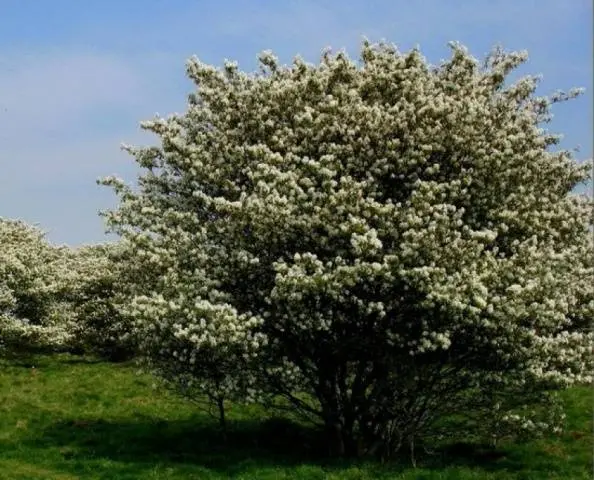
Irga is undemanding to the landing site. In places of natural growth, it is found even on rocky soils, penetrating into cracks between stones with its powerful, well-developed roots. Irga will grow well on loamy and sandy soils with acidity close to neutral. Irga does not like only close proximity to water. Wetlands should be avoided when planting.
Irga is a frost-resistant and drought-resistant plant, it easily withstands frosts of -40 degrees and does not need regular watering. The only exceptions are fruit varieties that need to be watered periodically during the ripening period of the berries. In addition to watering, to get a good harvest, bushes require top dressing, regular pruning, weeding with the removal of root shoots and loosening of tree trunks.
Planting irgi in open ground
Irgu is planted in a permanent place with seedlings at the age of 2–3 years. Before planting, you need to take into account some features of the shadberry associated with its cultivation in the open field.
- The life expectancy of a bush can reach 60-70 years. Replanting an adult bush is very laborious, so the landing site must be determined in advance.
- The height of an adult bush can reach 8 m, the width of the crown is 6 m, so the shadow from it will be significant.
- Most species of shadberry give numerous root shoots. It must be constantly removed, otherwise the bush will eventually turn into dense thickets.
- The roots of this plant are powerful and numerous; If you need to remove an adult bush, this will cause a lot of trouble, and it is unlikely that it will be possible to completely remove the roots.
- Irgi berries are a delicacy not only for people, but also for birds. To protect the crop, a special protective net will need to be thrown over the tree.
- Harvesting from high bushes will be very difficult. Therefore, it is better to give preference to low-growing varieties if the shrub is planted as a berry. In the future, it is necessary to form a crown and thin out the bush.
If the choice is made and all the nuances are taken into account, you can begin to prepare for landing.
When is the best time to plant irgu: in spring or autumn
Professional gardeners recommend planting irgu in the fall, after the leaves have fallen. At this time, the seedlings are full of energy and completely ready for winter. In addition, during this period, as a rule, there are no problems with planting material. Nevertheless, planting irgi in the spring can also be done, this must be done before the buds begin to swell on it. This shrub has an excellent survival rate, so there will be no problems with rooting the seedling.
Where to plant irgu
Irgu can be planted in any part of the garden. Shady places are no exception, but the shoots on them will be thinner, and the harvest will be poorer. It is optimal to plant shrubs along the northern border of the site. Irga is not afraid of the cold, and a hedge of bushes will reliably protect more tender bushes and trees from the north wind.
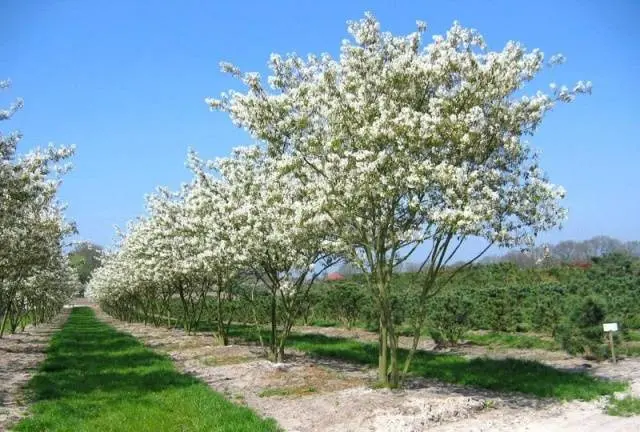
A place for planting irgi should not be near a fence or against a wall, powerful roots can damage the structure. It is undemanding to the type of soil, it is only important that the groundwater is far from the surface.
Before planting, the soil must be dug up in advance, while applying organic fertilizers. It is also better to dig the landing hole itself in advance so that the soil has time to saturate with air. For spring planting, a pit is prepared in the fall, for autumn – in 1,5–2 months.
Selection and preparation of seedlings
Usually, seedlings of 2-3 years of age are planted in a permanent place. By this time, its length should be at least 30–35 cm. It is advisable to choose seedlings with a clod of earth on the roots. Exposed roots should be inspected, rotten areas should be cut off.
How to plant irgu in spring: step by step instructions
The landing pit must have a depth of at least half a meter. Its dimensions depend on the size of the roots of the seedling, it is necessary that they fit freely in it and do not twist. Here is a step-by-step instruction for planting irgi in spring in open ground:
- Prepare several buckets of humus and earth, mixing them in a 1: 1 ratio.
- Add to the mixture 2 tbsp. spoons of superphosphate and 1 tbsp. a spoonful of potassium sulfate, stir.
- Pour the mixture at the bottom of the pit so that the root neck of the seedling is 5–6 cm below ground level.
- Set the seedling vertically, straighten the roots and gradually cover them with earth, preventing the formation of voids.
- Tamp the trunk circle, pour plenty of water (at least 30 l) and mulch with straw or sawdust.
Planting irgi in the spring with seedlings can be done in a checkerboard pattern, in a row or pointwise. Neighboring bushes should be located at a distance of at least 2,5 m from each other, when planted in a row to create hedges – 1–1,5 m.
What can be planted next to the irga
It is not recommended to plant trees with powerful roots next to the irga: birch, maple. Also, she will not get along next to all types of walnut, barberry, lilac and viburnum. Subject to the necessary distances, the neighbors of the irgi can be any stone fruits: apricot, plum, quince.
Irga care after landing
To obtain good yields and a beautiful appearance, the shadberry bush needs periodic pruning. In addition, it is necessary to keep the near-trunk circle clean, clearing it of weeds and periodically loosening. Periodic feeding and watering will also be useful.
Rules for competent watering
With a sufficient amount of precipitation, watering the irge is not required at all. Only recently planted seedlings need watering, they need to be watered regularly until young growth appears.
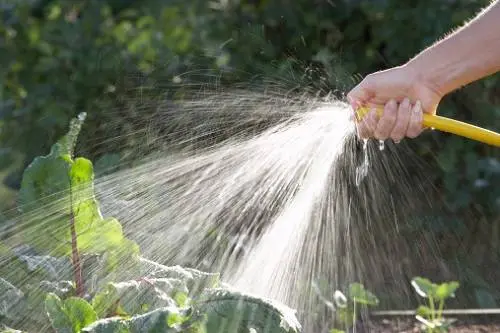
Adult bushes in dry times are watered at the rate of a bucket of water per day.
Loosening, weeding, mulching
Keeping the trunk circle clean is important not only from an aesthetic point of view. Regular weeding and loosening increases air access to the roots, which has a beneficial effect on the growth of the bush. It is also an opportunity to remove numerous root shoots. After cleaning the trunk circle, it is watered and mulched, this helps to slow down the growth of weeds and retains moisture in the soil.
Top dressing irgi in spring, summer and autumn
Irga does not require mandatory feeding, especially if planted in fertile soil. On poor sandy and clay soils, it is recommended to periodically feed the shrub with both organic and mineral fertilizers:
- In the spring, before the buds swell – nitroammophos 50 g per sq. m.
- In summer, during the ripening of berries – infusion of manure or bird droppings, diluted 0,5 liters per bucket of water, or urea in a proportion of 40 g per bucket.
- In the fall, along with digging up tree trunks – potassium sulfate and superphosphate, 1 and 2 tbsp. spoons, respectively, per sq. m.
Once every three years, you can make autumn feeding of adult bushes with humus at the rate of 3 buckets per 1 bush. This will prevent soil depletion.
When and how to cut the irgu
Pruning and shaping shadberry helps to properly grow a bush, increase its yield, rejuvenate plantings and get rid of old and dry branches. Pruning is done in several stages:
- Sanitary pruning – in the spring, before the start of sap flow and in the fall, after leaf fall. Broken, dried branches are cut out.
- Formative pruning is done for tree-like forms, while the vertical shoots are shortened by ¼, the side shoots are cut off completely. The crown at the same time begins to grow in breadth and takes the form of a hat.
- Thinning crop used for bush forms of irgi. At the same time, all root shoots are removed, leaving only 2-3 shoots annually. Gradually, the bush will be formed from 10–15 trunks of different ages. In the future, all thickening (growing inside the bush) branches are removed.
- Rejuvenating pruning involves the complete removal of trunks older than 7–8 years. It can be both partial and complete, during which the entire bush is cut out “under the stump”.
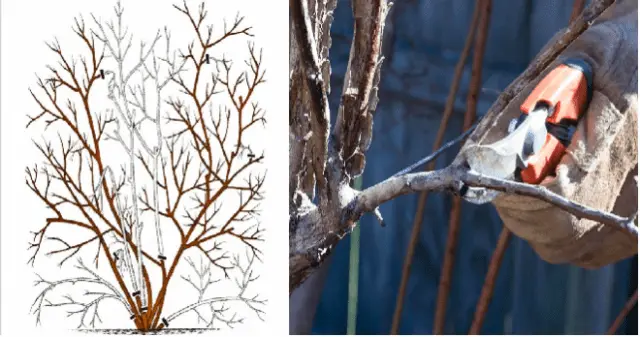
Pruning shadberry bushes is best done in the spring, before the buds swell. All places of cuts must be covered with garden pitch or painted over with oil paint.
Preparing the crop for winter
The winter hardiness of the irgi is sufficient for wintering without shelter. No measures, with the exception of sanitary measures, are required. If the autumn was dry, it is possible to produce the so-called water-charging watering after the end of leaf fall. After that, the trunk circle is mulched with peat or humus.
Planting and caring for irga in the Moscow region
The climate of the Moscow region is quite suitable for growing this shrub. With regard to planting and caring for the irga, all the recommendations given earlier will be valid. When planting, it should be borne in mind that the soils in the Moscow region have high acidity. Therefore, it is more expedient to add dolomite flour or lime to the composition of the nutrient soil.
Planting and caring for irga in the Moscow region, photo and video
Of the species, it is worth recommending the alder-leaved irgu or the Canadian irgu. These plants can be shaped into compact shrubs, making it much easier to pick berries and reduce losses from bird raids. In addition, these species are the most large-fruited and productive.
When and how to transplant an adult irgi bush
It is undesirable to transplant an adult (over 6 years old) bush to a new place. If such a need arose, the following recommendations should be followed.
- An adult plant is transplanted in the fall, one and a half to two months before frost.
- The bush is transplanted only together with a clod of earth.
- The length of the tap root must be left at least 0,8 m, lateral – at least 1 m.
- The planting hole for the transplanted bush must be of appropriate size.
- Bare roots for the time of transportation of the bush must be wrapped with wet rags.
- After planting, the ground should be well tamped and spilled with plenty of water.
How irga breeds
Irgu can be propagated quite simply. This can be done in any way characteristic of shrubs:
- seeds;
- cuttings;
- layering;
- root growth;
- division of the bush.
In addition, irgu can be grafted onto common or chokeberry, as well as hawthorn.
Propagation of irgi by cuttings
The best time to propagate irgi with green cuttings is the beginning of summer. By this time, the shoots already have a length of about 15 cm. Later lignified cuttings take root much worse, while more than half of the green ones take root. The top two leaves are left on the handle, cutting off half of them to reduce moisture evaporation. All lower leaves are removed.
For planting use pots with nutrient soil. Sections of the cuttings are treated with a special solution of a root formation stimulator, then the cutting is planted in the ground, deepening it by 2-3 buds.
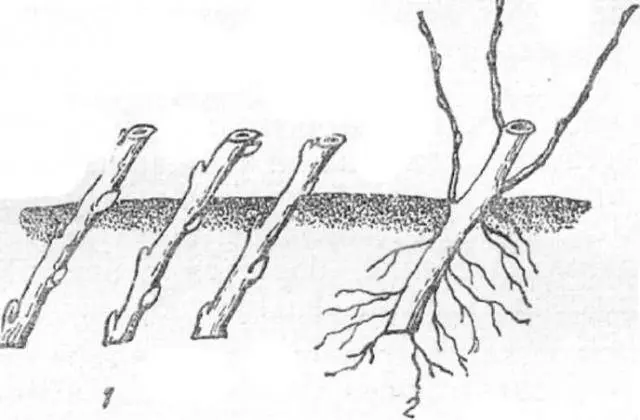
Planted cuttings are placed under the film. It is important to regularly moisten the soil at this time. In a month, the cuttings will have the first roots, and by the end of the next season they will be ready for planting in a permanent place.
seed method
Seeds for planting shadberry should be selected from large ripe berries. Before spring planting, they must be stratified by keeping them in the freezer for three months. Stratification can also occur naturally; for this, the seeds must be planted in open ground in the fall. A year later, annual seedlings dive.
Division of the bush
By dividing the bush, you can propagate the irgu no older than 7 years. This method is the most difficult, but it allows you to immediately get an adult fruit-bearing bush. To do this, in the fall, the irgu is completely dug up, a part of the rhizome is separated with an ax along with the shoots and planted in a new place. The roots of the mother and daughter bushes are again covered with earth and watered abundantly.
How to propagate irgu by layering
For propagation by layering, one or more side shoots of the shadberry bush are bent to the ground, securely fixed with metal brackets and covered with earth. This place is constantly moistened, which leads to the formation of roots and the appearance of new growth.
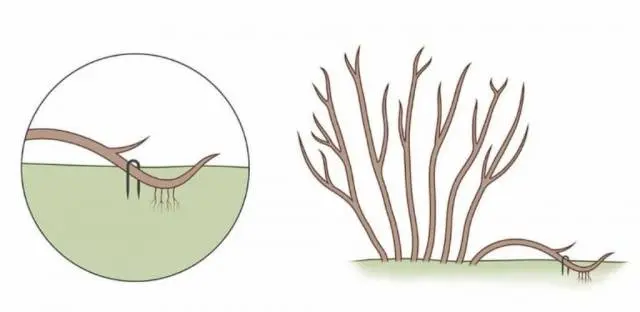
After the shoots reach a length of 30-35 cm, they are cut off from the parent bush and, together with a clod of earth, are transplanted to a permanent place.
Diseases and pests
Irga gets sick quite rarely. Fungal diseases can be found on neglected bushes, as well as when growing in conditions of excessive moisture. The most common diseases of irgi are shown in the table.
Disease | Symptoms | Treatment and prevention |
Ascochitosis | Irregular brown spots on leaves. Affected leaves die and fall off. The frost resistance of the bush drops sharply. | Treatment with Bordeaux liquid 1% until the kidneys swell. In case of severe damage, repeat the treatment in the fall. Affected leaves must be destroyed. |
Monilial rot | The berries rot and then dry up on the branch, becoming carriers of fungus spores. | Treatment with Bordeaux liquid 1% three times per season: before flowering, immediately after it and then after two weeks. |
Mučnistaâ rosa | Light gray spots on leaves. The affected leaf then darkens and falls off. | Treatment with Thiovit Jet or Raek. Infected leaves should be cut off and burned. |
Pestalotia | The leaves are starting to turn brown. The border of healthy and diseased tissue is yellow. | As in ascochitosis |
Septoria spotting | Numerous rounded small brown spots on the leaves. | As in ascochitosis |
Insect pests on this shrub can be found infrequently. But they are. The table lists some of them.
Insect | What harm do | Methods of control or prevention |
Rowan moth | The caterpillars of this butterfly live in berries. | At the end of the flowering period, the bushes are sprayed with karbofos or a similar preparation. It is recommended to re-treat 10-14 days after the first. |
Irgov seed-eater | The seed-eater larva lives inside the fruit, feeding on its seeds. | – // – |
Rowan fire | Butterfly caterpillars feed on fruit pulp | – // – |
Conclusion
Planting and caring for irga in the open field is within the power of any gardener. In addition to ease of cultivation, this shrub is also distinguished by good yields. Its berries contain many vitamins and minerals, they are tasty and healthy. Of these, it is good to cook compote, jam. You can make home-made fruit wine from shadberry, it is not for nothing that in Our Country it is also called a “wine” berry.

Blooming irga is not only very beautiful, it is also a wonderful honey plant. No wonder its Latin name is Amelanchier, which means “bringing honey.”









